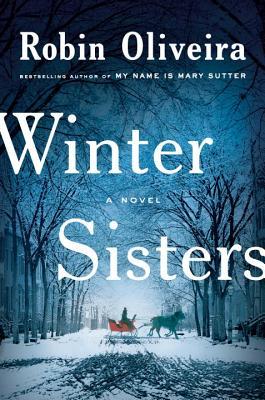When I first decided to read Winter Sisters, I hesitated and actually started and finished another book first. I think my hesitation was because I loved My Name is Mary Sutter so much, I didn’t want to be disappointed with Oliveira’s new novel featuring Mary Sutter. Well, that feeling was quickly dispelled, for Winter Sisters was fantastic. A 5-star read for me!
Oliveira dedicated this book “For girls and women everywhere.” It won’t take the reader long to understand the weight and the explosive significance of this dedication.
Winter Sisters definitely has heavier subject material within, and it can prove to be a difficult story to read at times since it focuses on the kidnapping, confinement and rape of two girls, Emma and Claire, named the winter sisters. But this explodes into a gripping, absolutely gripping, courtroom drama that is filled with suspense and was one I could not take my eyes away from. I marked many, many pages for their intensity, significance and proof that sadly, we have not come a long way, baby. Winter Sisters could easily be a contemporary read, not the historical fiction it is.
It opens on a day when a historic and ruthless blizzard crushes 1879 Albany. It claims the life of Emma and Claire’s parents, David and Bonnie O’Donnell. The O’Donnell’s are very close friends of Mary Sutter and her family. After days of being trapped inside their one room school room, Emma and Claire are released and free to go home. They are unaware of the fate of their parents, and exit the school excited to go home. But, they simply vanish into thin air. What happened to these sisters, now called the winter sisters? How can two girls simply disappear without a trace?
Mary Sutter is consumed with searching for the girls, refusing to believe the girls have been killed by the same blizzard that took their parents. What Mary uncovers will sicken her and shake the city of Albany to its core.
The girls are found following another dramatic weather incident for the city. As the city floods, they are discovered and brought to Mary and her husband’s home (I won’t reveal her husband’s identity in case you haven’t read My Name is Mary Sutter first. While you may not necesarily need to read it first, I would highly recommend it because Mary is such a wonderful character and to not get that background and development of how she became one of the first female doctors in Albany and the identity of her husband would be kind of tragic!) they find Emma and Claire in almost coma-like trances and Mary’s examination of Emma exposes gross evidence that brutal and continued rape occurred. They can only slowly reveal details about their harrowing captivity during the many weeks following the blizzard, and talk about their confinement by two men: one they refer to as the “Good Man” and the second as the “Other Man”.
As the story progresses, the identity of this “other man” does not become difficult to determine, but that is not really the point of the book, this is not necessarily about solving that mystery, rather it evolves into this explosive courtroom drama involving the son of the prosperous lumber king of Albany, Gerritt Van Der Veer. Gerritt forces his son to lead the defense for his right hand man, Mr. Harley. Harley is identified and accused in the kidnapping and rape of Emma and her sister Claire. To the girls, Harley is known as the “Good Man”, but no one believes the girls when they say there were two men involved, and the Good Man only kept them safe, but it was the Other Man responsible for ripping Emma’s life apart.
Jakob Van Der Veer, Gerritt’s son, is disgusted that he is expected to defend Harley, and is greatly conflicted as he is in love with Mary Sutter’s niece Elizabeth. How would he lead a case defending a man responsible for harming the two girls? The two girls in which Elizabeth feels as close to as sisters?
But Jakob Van Der Veer proves to be sensational and carefully builds a case to trap this “Other Man” into his stormy reveal. He pieces together slowly what he knows to be the truth, and it is the truth he expertly navigates towards revealing in the courtroom. The cover for Winter Sisters is outstanding and that red sleigh holds great significance. I so love it when the cover design is thoughtful and pertinent to the contents inside and under its cover.
Because Emma is ten years old, she is considered to be the legal age of consent in 1879 Albany, and Jakob understands a trial for the case of rape will be perilous and fraught one to argue in the courtroom.
“He’d studied a few rape trial transcripts to evaluate defense strategies. They seemed to consist mostly of heaping shame on the accuser: Do you wear underclothing under your dresses? Are you sure? Do you ever go without it? Did you that day? How can you remember? What were you doing alone in that part of town? Isn’t it true you have already had relations with other men? Aren’t you flirtatious by nature? How long have you been promiscuous? Did you even resist a little? Did you fight to the point of exhaustion? Why not? ….Did you scream? No? Why not? If you didn’t scream, then any reasonable man would take that as leave to do what he pleased.“
When Emma has to be questioned, tiny but courageous 10-year-old Emma, held in a stinking root cellar for weeks, repeatedly raped, has to take the stand, Jakob’s statements about rape cases prove to be dishearteningly true (and far too much like one that would happen in today’s courtrooms):
“You’re a strong girl Emma. You’re alive. Did you fight him? As much as you could? Her eyes glazed, and she whispered, “Yes, but it was hard. It felt like he was tearing me apart, like he was breaking me.” “You know the difference between right and wrong don’t you? Are you sure you didn’t really want it? Weren’t you secretly excited? Weren’t you curious? Didn’t you ask for it?”… And there it was, the smear of accusation and blame hurled in courtrooms and police stations everywhere at rape victims, though this time, perversely, it was not the defense attorney doing the hurling, but the prosecution. But Hotaling had maintained that his job was to dredge up every nasty suspicion a jury might entertain and mitigate each one before the defense could manipulate those same doubts in their favor.”
I could not take my eyes from the pages of this book! I was on the edge of my seat, always!
As well, we bear witness to continued and extreme sexism Mary Sutter faces for her audacity in thinking she can be a doctor. Even “friends” that dine with them in their home sling retorts of “shouldn’t Mary be in the kitchen taking care of her husband?” She’s consistently discredited, questioned and faces expulsion by the board of directors of the hospital for treating prostitutes in a private clinic. But don’t worry about Mary Sutter! In her true and wonderful style she shuts them all down, hard, for she can take care of herself and does it with her great style, grace and fierceness. It was well worth the 8-year wait for a new Mary Sutter novel and I really hope there’s more to come!


